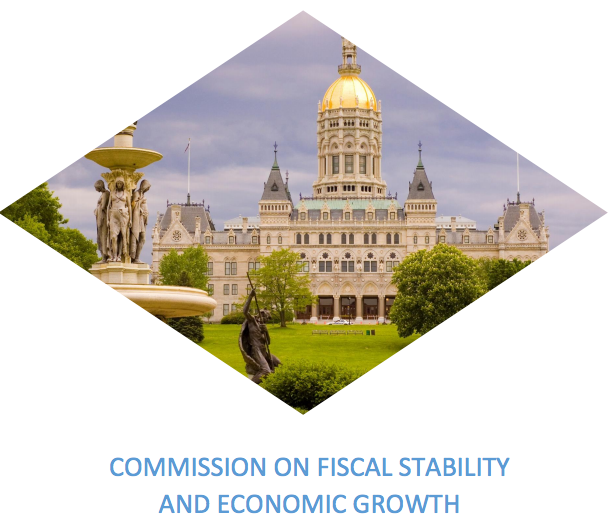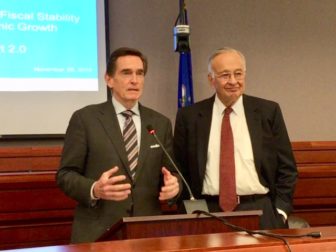A Second Effort to Sound a Fiscal Alarm in Connecticut

Audio By Carbonatix

The Commission on Fiscal Stability and Economic Growth issued its latest report on Wednesday, with suggestions members hope the new administration will heed.

Jim Smith, left, and Robert Patricelli. CTMirror.com
By Mark Pazniokas, CTMirror.org
The Commission on Fiscal Stability and Economic Growth produced a bleak assessment of Connecticut’s fiscal health for the incoming governor and General Assembly on Wednesday, the panel’s second attempt in nine months to convince policy leaders that the state is rapidly approaching a tipping point.
In a 32-page report (see PDF below), the commission sharpened a sprawling set of prescriptions initially issued on March 1, only to see its work attacked by labor and quickly shelved as a closely divided legislature turned to the short-term task of closing a deficit, balancing the state’s $20 billion budget, and campaigning for re-election.
The commission says the state needs to shrink spending by $1 billion, while adding revenue by modernizing its system of taxation and tax collection – not by raising tax rates. The panel backed away from a previous call to curtail collective bargaining for public employees, instead suggesting Gov.-elect Ned Lamont seek voluntary concessions.
“Now, the timing is right,” the commission says. “We have a new Governor-elect and General Assembly-elect, and a full legislative session coming in 2019. In this interim period we have refined and focused our recommendations, and now present our ‘Report 2.0.’ We believe it is the correct starting point for comprehensive and bipartisan reform. While our problems are severe, we are convinced they are fixable.”
The new report says the state is choking on fixed costs – primarily payments on debt, Medicaid and retirement benefits – that are growing by nearly 6 percent a year and will comprise “a staggering 53 percent” of all state spending in the fiscal year that begins July 1. Connecticut, it concludes, must shrink its budget by $1 billion.
“One of the things that we’ve discovered in the last nine months is people don’t understand the depth of the problems that have to do with fixed costs in Connecticut,” said Robert Patricelli, a retired corporate chief executive and the co-chair of the commission that was created by an act of the General Assembly.
Technically, the commission no longer exists. Led by Patricelli and the other co-chair, former Webster Bank chairman and CEO Jim Smith, the former commission members continued their work as private citizens, meeting over the summer and fall with political leaders and community groups as they revised their initial report.
“We spent the last nine months getting our message out,” Smith said. “We knew that completing the report was really just the beginning.”
The metrics of a state in fiscal crisis are stark, if familiar. Connecticut has posted budget deficits in every year but one from 2007 to 2016. Its economy actually shrank over 10 years, while the rest of the U.S. economy grew by more than 10 percent. And its unfunded pension liability is among the worst in the nation.
“Notwithstanding this bleak litany, there is some positive economic news in 2018. Job numbers and state GDP are growing modestly, and as a result state tax revenues are up over initial projections by several hundred million dollars,” the commission says. “In addition, the state has very important assets – its strategic location, highly educated workforce, wonderful topography, deep cultural and educational infrastructure, highly rated Bradley airport (third best in the nation according to user surveys), moderate housing prices compared to the megacities, high quality of life, and many other desirable attributes. Now we need to build on these assets.”
Patricelli and Smith said they have briefed the leaders of every caucus but the Senate Democrats, whose leader was traveling and not immediately available.
The new report is delivered as Lamont, a Democrat and Greenwich businessman who takes office as Connecticut’s 89th governor on Jan. 9, says he is looking for structural changes in state finances to break the cycle of deficits and stabilize the state’s economic climate. Lamont already has staked out a few positions consistent with the commission’s recommendations.
Lamont said he will not raise tax rates or dip deeply into the state’s suddenly flush budget reserves, but instead seek to improve tax collections and find other efficiencies, some of which he says may require negotiations with state employee unions that agreed to two rounds of concessions during the tenure of Gov. Dannel P. Malloy.
While state employees are due for pay raises after a freeze negotiated by Malloy, the commission is recommending extending the pay freeze, pointing to data indicating that Connecticut’s state employees and teachers are compensated better than their peers.
Average annual wages for state employees in Connecticut were $69,963 in 2016, second only to New Jersey. The average in the Northeast was $60,105. Connecticut teachers are paid annual wages 15 percent higher than the national average.
Teacher salaries are a local cost, but the woefully underfunded teacher retirement system is a state responsibility.
Sal Luciano, the leader of the Connecticut AFL-CIO, said labor is unlikely to provide significant givebacks, and he dismissed its latest work with the same insult he used in March, calling it the “Let Them Eat Cake Commission.”
“I would just say that the ‘Let Them Eat Cake Commission’ strikes again,” Luciano said after listening to the commission’s co-chairs brief the press for nearly an hour. “They start out with the fact that there is a billion dollars somehow that just can be taken out of the budget.”
Connecticut can afford higher income taxes and remain competitive with New York and New Jersey, Luciano said. But he acknowledged that the rate of growth in fixed costs are not sustainable.
Jan Hochadel, the president of AFT Connecticut, said the new report ignores the political realities of the past election: Democrats won strong majorities in each chamber of the General Assembly.
“The big business elites heading up this commission apparently missed one of the biggest takeaways from November 6: Connecticut voters aren’t buying the myth of trickle-down economics,” Hochadel said in a statement. “How else to explain a report pushing the kind of Trumpian austerity approach that lawmakers in Kansas and many other struggling states now openly admit doesn’t work?”
The commission’s co-chairs said there were aspects of their recommendations that would be difficult for labor and business.
The commission is recommending revenue-neutral tax reforms that it says would help stimulate economic growth, cutting the top income-tax rate from 6.99 percent to 6.7 percent and reducing business taxes.
It proposes trading $700 million in tax cuts for more than $600 million in new revenue raised by taxing online sales, and broadening the 6.35 percent sales tax to goods and services now exempt, such as legal and accounting services for consumers, parking, dry cleaning, non-prescription drugs, dentistry, veterinary care, and home renovations. The $600 million includes $148 million that would be raised by imposing a 2 percent sales tax on groceries.
The impact on lower-income residents would be mitigated by exempting groceries purchased by food stamps and other aid programs. The commission also proposes to raise the earned income tax credit back to 30 percent of the federal amount claimed and raising the minimum wage to $15 per hour.
The rest of the lost revenue would come from a 2 percent restaurant meals tax on top of the current sales tax, if the commission’s recommendations are accepted.
The commission proposed a modest approach to electronic tolling – limiting them to new projects that cut congestion, such as new lanes on I-95.
“This would not be a statewide system of tolls, which has so inflamed the public debate, but a project financing revenue bond vehicle,” the commission said. “Under federal law, we can collect targeted tolls on bridges and viaducts and for variable pricing or decongestion highway projects and for rail improvements in those same corridors.”
Reprinted with permission of The Connecticut Mirror. The author can be reached at [email protected].
Like what you see here? Click here to subscribe to We-Ha’s newsletter so you’ll always be in the know about what’s happening in West Hartford!
